|
|
|
Sort Order |
|
|
|
Items / Page
|
|
|
|
|
|
|
| Srl | Item |
| 1 |
ID:
131240
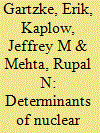

|
|
|
|
|
| Publication |
2014.
|
| Summary/Abstract |
A substantial literature examines the causes of nuclear proliferation, but few studies have addressed why states decide on a particular portfolio of weapon systems once they have acquired a basic nuclear capability. We advance a portfolio theory of nuclear force structure, positing that states seek a diverse set of capabilities for nuclear deterrence, but that they also face major resource and organizational constraints. A number of factors may help to explain the portfolio of nuclear forces that states ultimately field, including resource availability, experience as a nuclear power, bureaucratic politics, the conventional threat environment, the presence of nuclear rivals, and the maintenance of nuclear alliances. We test the influence of these factors on force structure using a new data set of nuclear weapon platforms fielded by nine nuclear nations between 1950 and 2000. Our findings represent an important step in understanding the drivers of nuclear behavior after states have joined the nuclear weapons club.
|
|
|
|
|
|
|
|
|
|
|
|
|
|
|
|
| 2 |
ID:
131236
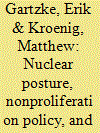

|
|
|
|
|
| Publication |
2014.
|
| Summary/Abstract |
What is the relationship between nuclear postures and nonproliferation policies and the spread of nuclear weapons? At first blush, this might appear to be an obvious question. After all, states go to great lengths-extending nuclear security guarantees to nonnuclear weapon states, forward-deploying nuclear weapons on the territory of allies, sizing their own nuclear arsenals with the proliferation decisions of other states in mind, supporting international institutions in conducting inspections of nuclear facilities in nonnuclear weapon states, restricting the availability of sensitive nuclear technology, applying and enforcing sanctions against would-be proliferators, conducting military strikes against nuclear facilities, and promoting nuclear cooperation for peaceful purposes, among many other steps-to prevent the spread of nuclear weapons. It would be strange to imagine that states pursue such actions unless they can expect a policy payoff in terms of peace or security. Yet, there is little systematic evidence to suggest that nuclear postures and policies have a meaningful impact on the spread of nuclear weapons.
|
|
|
|
|
|
|
|
|
|
|
|
|
|
|
|
| 3 |
ID:
131239
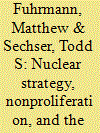

|
|
|
|
|
| Publication |
2014.
|
| Summary/Abstract |
Why do countries deploy nuclear weapons abroad? Since 1945, more than twenty states have hosted foreign nuclear weapons on their territory, and five countries continue to do so today. These deployments have important consequences for international security, yet there is little systematic research about the factors that drive them. In this article, we develop three broad theoretical frameworks to explain why foreign nuclear deployments occur. Using a new data set of foreign nuclear deployments between 1945 and 2000, we find that two factors weigh heavily in driving these deployments: the protection of allies and the projection of military power. Nonproliferation motives, however, appear to play little role. The results carry important implications for our understanding of the causes of proliferation and the sources of nuclear posture.
|
|
|
|
|
|
|
|
|
|
|
|
|
|
|
|
| 4 |
ID:
131241
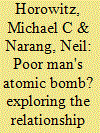

|
|
|
|
|
| Publication |
2014.
|
| Summary/Abstract |
The causes and consequences of nuclear proliferation have received a great deal of academic attention. However, nuclear weapons are rarely discussed in isolation in policy circles. Instead, nuclear weapons are relevant as part of a category of weapons of mass destruction (WMDs) that includes chemical and biological weapons (CBWs). Are the factors that drive CBWs proliferation similar to those that drive nuclear proliferation? What is the relationship between these weapons types? In this article, we explore whether nuclear weapons and CBWs serve as complements or substitutes. Using newly collected data on both CBWs pursuit and possession over time, we find that nuclear, biological, and chemical weapons generally function as complements at the pursuit stage. In addition, countries that acquire nuclear weapons become less interested in pursuing other types of WMDs and are even willing to give them up in some cases.
|
|
|
|
|
|
|
|
|
|
|
|
|
|
|
|
| 5 |
ID:
131238
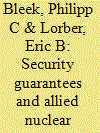

|
|
|
|
|
| Publication |
2014.
|
| Summary/Abstract |
As Iran continues its apparent pursuit of a nuclear weapons breakout capability and North Korea resists efforts to roll back its proliferation, policy makers in Washington eager to prevent further proliferation in both regions regard security guarantees to allies as crucial tools. But recent scholarship calls into question whether security guarantees ameliorate proliferation risks. Relying on a combination of large-N quantitative analysis and a case study of South Korea from the late 1960s to the mid-1980s, this article argues that, consistent with policy makers' conventional wisdom, security guarantees significantly reduce proliferation proclivity among their recipients.
|
|
|
|
|
|
|
|
|
|
|
|
|
|
|
|
| 6 |
ID:
131237


|
|
|
|
|
| Publication |
2014.
|
| Summary/Abstract |
A growing literature suggests that nuclear assistance from other countries is an important determinant of whether states pursue nuclear weapons. Existing work does not consider, however, the most widely available source of assistance-the Technical Cooperation (TC) program administered by the International Atomic Energy Agency (IAEA). IAEA assistance is an important piece of the nonproliferation regime's central bargain: member states enjoy nuclear assistance in exchange for agreeing not to seek nuclear weapons. Using a data set of TC projects since 1972, we examine whether international nuclear assistance is associated with the pursuit of nuclear weapons. We hypothesize that some TC assistance reduces the cost of pursuing nuclear weapons, making weapons programs more likely. We find that receiving TC related to the nuclear fuel cycle is a statistically and substantively significant factor in state decisions since 1972 to seek nuclear weapons, with important implications for existing theories of nuclear proliferation.
|
|
|
|
|
|
|
|
|
|
|
|
|
|
|
|
|
|
|
|
|